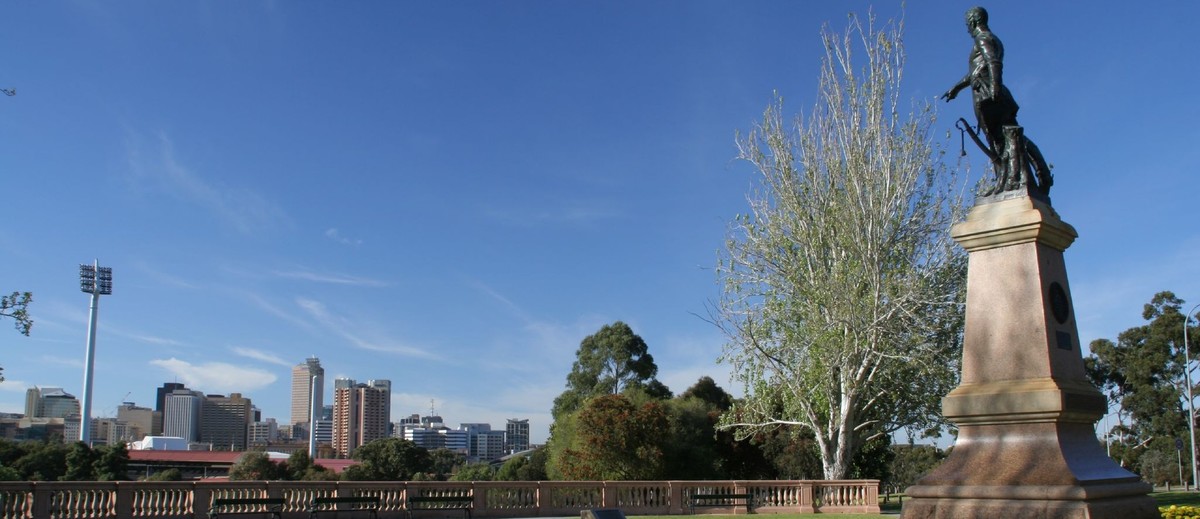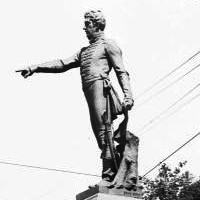Distinguished soldier, sailor, linguist, musician and painter Colonel William Light (1786–1839) was the first surveyor-general of South Australia. Light commanded the brig Rapid for its voyage to the new colony. Reaching Kangaroo Island on 19 August 1836, Light immediately began to search for the most appropriate site for the colony’s capital. He had been given sole responsibility for choosing its location.
After considering various sites, including Port Lincoln and Encounter Bay, Light placed Adelaide a little inland from the sea on the banks of a river, which wound across a fertile plain from nearby hills. However, his choice was opposed by prominent figures, not least of whom was Governor John Hindmarsh who wanted the capital to be a port and therefore located at Port Lincoln, Port Adelaide or Encounter Bay. But Light persisted and won the day. He could see that his site gave best access to fresh water, minimised the threat of flooding and presented good ground on which to build, while still being close to a suitable harbour.
Light the surveyor
On 11 January 1837 Light began his survey for the capital. His plan for North Adelaide and South Adelaide (now the central business district) on either side of the River Torrens and surrounded by a belt of parklands, was completed by May of that year. Light’s Plan, with its grid layout of streets and squares, is the foundation and guiding framework of the City of Adelaide.
Colonel Light was also required to survey more than 2400km of the coastline and surrounding countryside, to divide 150 square miles (c. 390km2) of country into sections and to reserve areas for country towns. This huge task was expected to be completed within two months. Light found that he had insufficient staff and resources to undertake the work. Light and Resident Commissioner James Hurtle Fisher sent Light’s deputy, George Strickland Kingston, to England to request additional support. The South Australian Colonisation Commissioners in Britain not only rejected the request, but also insisted that trigonometry surveys be replaced by faster ‘running surveys’. If Light refused to do this form of survey, he was to be replaced by Kingston and relegated to other work. On 2 July 1838 Light resigned with all but two of his staff.
Light’s demise
Light then became a principal partner in the surveying firm of Light, Finniss & Co. However, his health deteriorated rapidly and he was unable to continue working in the next year. His circumstances were not helped by a fire on the day after he ceased work: on 22 January 1839 at 2pm his hut and the Survey Office on North Terrace burnt to the ground. The fire had commenced in Fisher’s neighbouring residence, which it destroyed along with the Land Office. The Southern Australian of 23 January 1839 reported that various official records and maps in the offices were saved, but Fisher and Light witnessed
the total destruction of their houses, furniture, books … live stock … and, what is beyond all the rest, being irremediable, their private accounts and papers. Scarcely an article of any value has been saved by either party from the devouring element … amongst in Colonel Light's losses we must include several of his instruments, the whole of his valuable portfolios of drawings executed during his residence in Egypt and in the Peninsula, and what as colonists we yet more regret, the private journal he has diligently kept for the last 30 years. So rapid was the progress of the flames that the inmates in either residence had scarcely time to escape.
Nursed by his partner Maria Gandy, Colonel Light died of tuberculosis at his Thebarton home on 6 October 1839. He was given the first official funeral procession in South Australia and buried in the city square that bears his name. A public meeting to discuss a monument to the memory of Light was held just eight days after his death. In 1843 a neo-Gothic monument in sandstone was erected over his grave.
The statue
By the early 1890s the monument to Colonel William Light in Light Square was weathered beyond repair. A committee formed in January 1892 to replace it decided also to erect a statue in his honour. Matters then lingered until the early 1900s when funds from the state government, the Adelaide City Council and private subscribers were committed to both tasks. In February 1904 the funds were transferred to the Adelaide City Council for a statue to be located in the heart of the city, Victoria Square and for another monument to be erected on Light’s resting place.
After the new monument in Light Square was raised in June 1905, the committee still had sufficient funds for a bronze statue. A design by Scottish sculptor William Bernie Rhind (1853–1933) was selected from the 13 entries in a design competition. Edinburgh-born Rhind was principally known for his architectural sculptures.
Rhind depicted Colonel Light in the uniform of the British Royal Engineers. He is holding a map in his left hand while pointing with his extended right arm. The bronze statue stands on a pedestal of textured and polished grey granite and Murray Bridge red granite. The pedestal was designed by local architects Garlick, Sibley & Wooldridge.
The unveiling in Victoria Square
The statue of Colonel William Light was placed at the northern junction of King William Street and Victoria Square where Governor Le Hunte unveiled it on Tuesday morning, 27 November 1906. The watching crowd was so large it overflowed into Flinders Street and Franklin Street. Children from the public schools were well represented. Cadets and infantry provided a guard of honour for the governor and the Police Band played the ‘Song of Australia’ and the ‘National Anthem’.
People who had arrived in the colony of South Australia prior to 1845 were invited as special guests. Several of these old settlers remembered Colonel Light. They shared the platform with Chief Justice Sir Samuel Way, Premier Tom Price, Mayor Theodore Bruce, city councillors and the Colonel Light Monument Committee. Way and Bruce addressed the gathering before the unveiling.
Towards the end of the ceremony a school boy called out, ‘What about a half-holiday?’ whereupon the governor turned to the Education Department representative Mr Neale and asked him to grant the holiday. Neale acquiesced, to much applause.
Up on Montefiore Hill
It was not long before the statue became the focus of a planning dispute. Light stood in the centre of an increasingly busy intersection, surrounded by wires and trams. By 1908 requests were being made to move the statue because it was a hazard to traffic.
But it was not until South Australia’s centenary in 1936 that relocation was given serious consideration. It was prompted by the development of a lookout on Montefiore Hill as a centenary project to honour the pioneers. Then early in 1938 Sir Henry Newland (1873–1969), an Adelaide surgeon and president of the Pioneers Association of South Australia, suggested redesigning and expanding the area, shifting the statue there and renaming the precinct ‘Light’s Vision’ in time for the centenary of Light’s death.
Although the association’s grand plan was rejected by the council, it accepted the name and the relocating of the statue which in May 1938 was moved to Montefiore Hill where it became the centrepiece of the balustraded garden lookout. Until 2013 Light stood with his right index finger pointing to the city below, but the redeveloped Adelaide Oval now obscures the view and has lessened the impact of a visit to Light’s Vision.
Inscription and plaques
The inscription on the front of the pedestal acknowledges Light’s role in locating and planning Adelaide. On the back of the pedestal is a wreath added by the first Australian town planning conference held in Adelaide in 1917. An extract from A brief journal of the proceedings of William Light, where Light thanks his enemies for giving him the sole responsibility of choosing the site of Adelaide, is reproduced below the wreath: ‘The reasons that led me to fix Adelaide where it is I do not expect to be generally understood or calmly judged of at present … I leave it to posterity … to decide whether I am entitled to praise or blame’.

I've heard that too Gary, but I'm not sure if it's fact or one of those stories that has been repeated so many times it feels true! I'll see if we can find out.
I read sometime ago that the reason for the open parklands, north,south,east and west surrounding Adelaide was a defensive move by Light and the distance was how far a cannon ball could travel in the case of attack .
‘William Birnie Rhind (1853-1933)’, Glasgow – City of Sculpture, http://www.glasgowsculpture.com/pg_biography.php?sub=rhind_wb, accessed 15 April 2013
Advertiser, 28 November 1906, ‘The Colonel Light statue: Unveiling ceremony’, pp7–8
Advertiser, 21 January 1938, ‘Memorial to Colonel Light: Proposed conversion of Montefiore Hill’ (25), ‘An architect’s sketch’ (p26)
Advertiser, 29 March 1938, ‘Light statue to be moved: Council decision on majority of one’ p19
Cameron, Simon, Silent witnesses: Adelaide’s statues and monuments (Adelaide: Wakefield Press, 1997)
Elder, David F, 'Light, William (1786–1839)', Australian Dictionary of Biography, National Centre of Biography, Australian National University, http://adb.anu.edu.au/biography/light-william-2359/text3089, accessed 15 April 2013
Light, William, A brief journal of the proceedings of William Light (Adelaide: William Light, 1839)
Register, 21 November 1906, ‘Col. Light statue’, p4
Register, 24 November 1906, ‘Colonel light statue: Ceremony of unveiling’, p8
Register, 28 November 1906, ‘The founder of Adelaide: Col. Light statue: Unveiling ceremony’, p9
Register, 31 October 1905, ‘Statue to Colonel Light’, p4
Southern Australian, ‘Destructive fire’, 23 January 1839, pp2–3



Add your comment